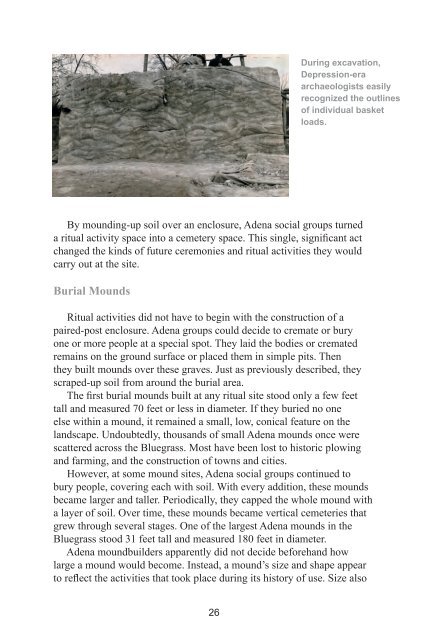woodland period moundbuilders of the bluegrass - Kentucky ...
woodland period moundbuilders of the bluegrass - Kentucky ...
woodland period moundbuilders of the bluegrass - Kentucky ...
- No tags were found...
You also want an ePaper? Increase the reach of your titles
YUMPU automatically turns print PDFs into web optimized ePapers that Google loves.
During excavation,Depression-eraarchaeologists easilyrecognized <strong>the</strong> outlines<strong>of</strong> individual basketloads.By mounding-up soil over an enclosure, Adena social groups turneda ritual activity space into a cemetery space. This single, significant actchanged <strong>the</strong> kinds <strong>of</strong> future ceremonies and ritual activities <strong>the</strong>y wouldcarry out at <strong>the</strong> site.Burial MoundsRitual activities did not have to begin with <strong>the</strong> construction <strong>of</strong> apaired-post enclosure. Adena groups could decide to cremate or buryone or more people at a special spot. They laid <strong>the</strong> bodies or crematedremains on <strong>the</strong> ground surface or placed <strong>the</strong>m in simple pits. Then<strong>the</strong>y built mounds over <strong>the</strong>se graves. Just as previously described, <strong>the</strong>yscraped-up soil from around <strong>the</strong> burial area.The first burial mounds built at any ritual site stood only a few feettall and measured 70 feet or less in diameter. If <strong>the</strong>y buried no oneelse within a mound, it remained a small, low, conical feature on <strong>the</strong>landscape. Undoubtedly, thousands <strong>of</strong> small Adena mounds once werescattered across <strong>the</strong> Bluegrass. Most have been lost to historic plowingand farming, and <strong>the</strong> construction <strong>of</strong> towns and cities.However, at some mound sites, Adena social groups continued tobury people, covering each with soil. With every addition, <strong>the</strong>se moundsbecame larger and taller. Periodically, <strong>the</strong>y capped <strong>the</strong> whole mound witha layer <strong>of</strong> soil. Over time, <strong>the</strong>se mounds became vertical cemeteries thatgrew through several stages. One <strong>of</strong> <strong>the</strong> largest Adena mounds in <strong>the</strong>Bluegrass stood 31 feet tall and measured 180 feet in diameter.Adena <strong>moundbuilders</strong> apparently did not decide beforehand howlarge a mound would become. Instead, a mound’s size and shape appearto reflect <strong>the</strong> activities that took place during its history <strong>of</strong> use. Size also26
















